Characteristic Reactions of Iron (Fe³⁺)
- Page ID
- 97270
\( \newcommand{\vecs}[1]{\overset { \scriptstyle \rightharpoonup} {\mathbf{#1}} } \)
\( \newcommand{\vecd}[1]{\overset{-\!-\!\rightharpoonup}{\vphantom{a}\smash {#1}}} \)
\( \newcommand{\dsum}{\displaystyle\sum\limits} \)
\( \newcommand{\dint}{\displaystyle\int\limits} \)
\( \newcommand{\dlim}{\displaystyle\lim\limits} \)
\( \newcommand{\id}{\mathrm{id}}\) \( \newcommand{\Span}{\mathrm{span}}\)
( \newcommand{\kernel}{\mathrm{null}\,}\) \( \newcommand{\range}{\mathrm{range}\,}\)
\( \newcommand{\RealPart}{\mathrm{Re}}\) \( \newcommand{\ImaginaryPart}{\mathrm{Im}}\)
\( \newcommand{\Argument}{\mathrm{Arg}}\) \( \newcommand{\norm}[1]{\| #1 \|}\)
\( \newcommand{\inner}[2]{\langle #1, #2 \rangle}\)
\( \newcommand{\Span}{\mathrm{span}}\)
\( \newcommand{\id}{\mathrm{id}}\)
\( \newcommand{\Span}{\mathrm{span}}\)
\( \newcommand{\kernel}{\mathrm{null}\,}\)
\( \newcommand{\range}{\mathrm{range}\,}\)
\( \newcommand{\RealPart}{\mathrm{Re}}\)
\( \newcommand{\ImaginaryPart}{\mathrm{Im}}\)
\( \newcommand{\Argument}{\mathrm{Arg}}\)
\( \newcommand{\norm}[1]{\| #1 \|}\)
\( \newcommand{\inner}[2]{\langle #1, #2 \rangle}\)
\( \newcommand{\Span}{\mathrm{span}}\) \( \newcommand{\AA}{\unicode[.8,0]{x212B}}\)
\( \newcommand{\vectorA}[1]{\vec{#1}} % arrow\)
\( \newcommand{\vectorAt}[1]{\vec{\text{#1}}} % arrow\)
\( \newcommand{\vectorB}[1]{\overset { \scriptstyle \rightharpoonup} {\mathbf{#1}} } \)
\( \newcommand{\vectorC}[1]{\textbf{#1}} \)
\( \newcommand{\vectorD}[1]{\overrightarrow{#1}} \)
\( \newcommand{\vectorDt}[1]{\overrightarrow{\text{#1}}} \)
\( \newcommand{\vectE}[1]{\overset{-\!-\!\rightharpoonup}{\vphantom{a}\smash{\mathbf {#1}}}} \)
\( \newcommand{\vecs}[1]{\overset { \scriptstyle \rightharpoonup} {\mathbf{#1}} } \)
\( \newcommand{\vecd}[1]{\overset{-\!-\!\rightharpoonup}{\vphantom{a}\smash {#1}}} \)
\(\newcommand{\avec}{\mathbf a}\) \(\newcommand{\bvec}{\mathbf b}\) \(\newcommand{\cvec}{\mathbf c}\) \(\newcommand{\dvec}{\mathbf d}\) \(\newcommand{\dtil}{\widetilde{\mathbf d}}\) \(\newcommand{\evec}{\mathbf e}\) \(\newcommand{\fvec}{\mathbf f}\) \(\newcommand{\nvec}{\mathbf n}\) \(\newcommand{\pvec}{\mathbf p}\) \(\newcommand{\qvec}{\mathbf q}\) \(\newcommand{\svec}{\mathbf s}\) \(\newcommand{\tvec}{\mathbf t}\) \(\newcommand{\uvec}{\mathbf u}\) \(\newcommand{\vvec}{\mathbf v}\) \(\newcommand{\wvec}{\mathbf w}\) \(\newcommand{\xvec}{\mathbf x}\) \(\newcommand{\yvec}{\mathbf y}\) \(\newcommand{\zvec}{\mathbf z}\) \(\newcommand{\rvec}{\mathbf r}\) \(\newcommand{\mvec}{\mathbf m}\) \(\newcommand{\zerovec}{\mathbf 0}\) \(\newcommand{\onevec}{\mathbf 1}\) \(\newcommand{\real}{\mathbb R}\) \(\newcommand{\twovec}[2]{\left[\begin{array}{r}#1 \\ #2 \end{array}\right]}\) \(\newcommand{\ctwovec}[2]{\left[\begin{array}{c}#1 \\ #2 \end{array}\right]}\) \(\newcommand{\threevec}[3]{\left[\begin{array}{r}#1 \\ #2 \\ #3 \end{array}\right]}\) \(\newcommand{\cthreevec}[3]{\left[\begin{array}{c}#1 \\ #2 \\ #3 \end{array}\right]}\) \(\newcommand{\fourvec}[4]{\left[\begin{array}{r}#1 \\ #2 \\ #3 \\ #4 \end{array}\right]}\) \(\newcommand{\cfourvec}[4]{\left[\begin{array}{c}#1 \\ #2 \\ #3 \\ #4 \end{array}\right]}\) \(\newcommand{\fivevec}[5]{\left[\begin{array}{r}#1 \\ #2 \\ #3 \\ #4 \\ #5 \\ \end{array}\right]}\) \(\newcommand{\cfivevec}[5]{\left[\begin{array}{c}#1 \\ #2 \\ #3 \\ #4 \\ #5 \\ \end{array}\right]}\) \(\newcommand{\mattwo}[4]{\left[\begin{array}{rr}#1 \amp #2 \\ #3 \amp #4 \\ \end{array}\right]}\) \(\newcommand{\laspan}[1]{\text{Span}\{#1\}}\) \(\newcommand{\bcal}{\cal B}\) \(\newcommand{\ccal}{\cal C}\) \(\newcommand{\scal}{\cal S}\) \(\newcommand{\wcal}{\cal W}\) \(\newcommand{\ecal}{\cal E}\) \(\newcommand{\coords}[2]{\left\{#1\right\}_{#2}}\) \(\newcommand{\gray}[1]{\color{gray}{#1}}\) \(\newcommand{\lgray}[1]{\color{lightgray}{#1}}\) \(\newcommand{\rank}{\operatorname{rank}}\) \(\newcommand{\row}{\text{Row}}\) \(\newcommand{\col}{\text{Col}}\) \(\renewcommand{\row}{\text{Row}}\) \(\newcommand{\nul}{\text{Nul}}\) \(\newcommand{\var}{\text{Var}}\) \(\newcommand{\corr}{\text{corr}}\) \(\newcommand{\len}[1]{\left|#1\right|}\) \(\newcommand{\bbar}{\overline{\bvec}}\) \(\newcommand{\bhat}{\widehat{\bvec}}\) \(\newcommand{\bperp}{\bvec^\perp}\) \(\newcommand{\xhat}{\widehat{\xvec}}\) \(\newcommand{\vhat}{\widehat{\vvec}}\) \(\newcommand{\uhat}{\widehat{\uvec}}\) \(\newcommand{\what}{\widehat{\wvec}}\) \(\newcommand{\Sighat}{\widehat{\Sigma}}\) \(\newcommand{\lt}{<}\) \(\newcommand{\gt}{>}\) \(\newcommand{\amp}{&}\) \(\definecolor{fillinmathshade}{gray}{0.9}\)- Most common oxidation states: +2, +3
- M.P. 1535º
- B.P. 2750º
- Density 7.87 g/cm3
- Characteristics: Iron is a gray, moderately active metal.
Characteristic reactions of Fe²⁺ and Fe³⁺
The \(\ce{[Fe(H2O)6]^{3+}}\) ion is colorless (or pale pink), but many solutions containing this ion are yellow or amber-colored because of hydrolysis. Iron in both oxidation states forms many complex ions.
Aqueous Ammonia
Aqueous ammonia reacts with Fe(II) ions to produce white gelatinous \(\ce{Fe(OH)2}\), which oxidizes to form red-brown \(\ce{Fe(OH)3}\):
\[\ce{Fe^{2+}(aq) + 2NH3(aq) + 3H2O(l) <=> Fe(OH)2(s) + 2NH4^{+}(aq)} \nonumber \]
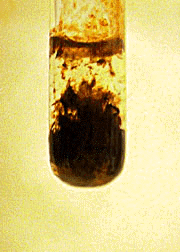
Aqueous ammonia reacts with \(\ce{Fe(III)}\) ions to produce red-brown \(\ce{Fe(OH)3}\):
\[\ce{Fe^{3+}(aq) + 3NH3(aq) + 3H2O(l) <=> Fe(OH)3(s) + 3NH4^{+}(aq)} \nonumber \]
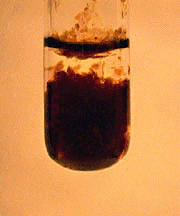
Both precipitates are insoluble in excess aqueous ammonia. Iron(II) hydroxide quickly oxidizes to \(\ce{Fe(OH)3}\) in the presence of air or other oxidizing agents.
Sodium Hydroxide
Sodium hydroxide also produces \(\ce{Fe(OH)2}\) and \(\ce{Fe(OH)3}\) from the corresponding oxidation states of iron in aqueous solution.
\[\ce{Fe^{2+}(aq) + 2OH^{-}(aq) <=> Fe(OH)2(s)} \nonumber \]
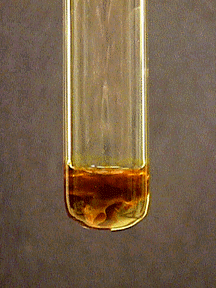
\[\ce{Fe^{3+}(aq) + 3OH^{-}(aq) <=> Fe(OH)3(s)} \nonumber \]
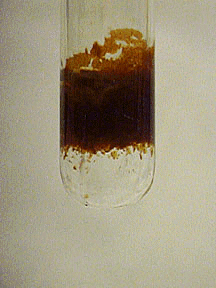
Neither hydroxide precipitate dissolves in excess sodium hydroxide.
Potassium Ferrocyanide
Potassium ferrocyanide will react with \(\ce{Fe^{3+}}\) solution to produce a dark blue precipitate called Prussian blue:
\[\ce{K^{+}(aq) + Fe^{3+}(aq) + [Fe(CN)6]^{4-}(aq) <=> KFe[Fe(CN)6](s)} \label{Prussian} \]
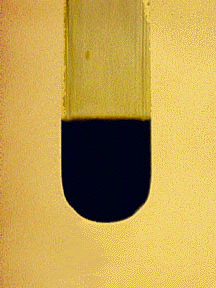
With \(\ce{Fe^{2+}}\) solution, a white precipitate will be formed that will be converted to blue due to the oxidation by oxygen in air:
\[\ce{2Fe^{2+}(aq) + [Fe(CN)6]^{4-}(aq) <=> Fe2[Fe(CN)6](s) } \nonumber \]
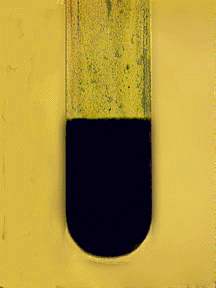
Many metal ions form ferrocyanide precipitates, so potassium ferrocyanide is not a good reagent for separating metal ions. It is used more commonly as a confirmatory test.
Potassium Ferricyanide
Potassium ferricyanide will give a brown coloration but no precipitate with \(\ce{Fe^{3+}}\). With \(\ce{Fe^{2+}}\), a dark blue precipitate is formed. Although this precipitate is known as Turnbull's blue, it is identical with Prussian blue (from Equation \ref{Prussian}).
\[\ce{K+(aq) + Fe2+(aq) + [Fe(CN)6]^{3-}(aq) <=> KFe[Fe(CN)6](s)} \nonumber \]
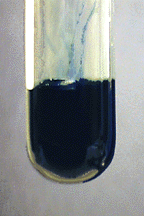
Potassium Thiocyanate
\(\ce{KSCN}\) will give a deep red coloration to solutions containing \(\ce{Fe^{3+}}\):
\[\ce{Fe3+(aq) + NCS^{-}(aq) <=> [FeNCS]2+(aq)} \nonumber \]
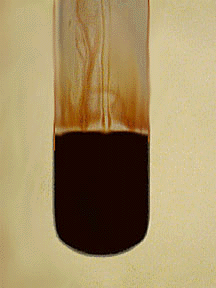
No Reaction
\(\ce{Cl^{-}}\), \(\ce{SO4^{2-}}\)


